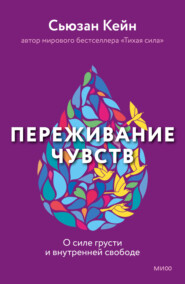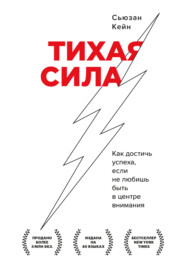По всем вопросам обращайтесь на: info@litportal.ru
(©) 2003-2024.
✖
Интроверты
Настройки чтения
Размер шрифта
Высота строк
Поля
200
Л’Энгл М. Складка времени. / Мир приключений. Сост. В. Мальт; М.: Детская литература, 1990.
201
Charles Darwin. The Correspondence of Charles Darwin. Volume 2: 1837–1843. – Cambridge, England: Cambridge University Press, 1987. – P. 67.
202
Информацию об этом исследовании можно найти в книге: Том Демарко, Тимоти Листер. Человеческий фактор. Успешные проекты и команды. – Символ-плюс, 2009.
203
См., например: 1) Vinesh Oommen et al. Should Health Service Managers Embrace Open Plan Work Environments? A Review / Asia Pacific Journal of Health Management 3, no. 2 (2008); 2) Aoife Brennan et al. Traditional Versus Open Office Design: A Longitudinal Field Study / Environment and Behavior 34 (2002): 279; 3) James C. McElroy, Paula Morrow. Employee Reactions to Office Redesign: A Naturally Occurring Quasi-Field Experiment in a Multi-Generational Setting / Human Relations 63 (2010): 609; 4) Einar De Croon et al. The Effect of Office Concepts on Worker Health and Performance: A Systematic Review of the Literature / Ergonomics, 48, no. 2 (2005): 119–34; 5) J. Pejtersen et al. Indoor Climate, Psychosocial Work Environment and Symptoms in Open-Plan Offices / Indoor Air 16, no. 5 (2006): 392–401; 6) Herman Miller Research Summary, 2007: «It’s All About Me: The Benefits of Personal Control at Work»; 7) Paul Bell et al. Environmental Psychology. – Lawrence Erlbaum, 2005. – P. 162; 8) Matthew Davis et al. The Physical Environment of the Office.
204
Такое название намекает на реакцию древнего человека при встрече с опасностью. Прим. ред.
205
Marc G. Berman et al. The Cognitive Benefits of Interacting with Nature / Psychological Science 19, no. 12 (2008): 1207–12. См. также Stephen Kaplan, Marc Berman. Directed Attention as a Common Resource for Executive Functioning and Self-Regulation / Perspectives on Psychological Science 5, no. 1 (2010): 43–57.
206
Matthew Davis et al. The Physical Environment of the Office.
207
John Medina. Brain Rules. – Seattle, WA: Pear Press, 2008. – P. 87.
208
Из интервью автора с Майком Микой от 12 июля 2012 года.
209
Kimberly Blanton. Design It Yourself: Pleasing Offices Laid Out by the Workers Who Use Them Can Be a Big Advantage When Companies Compete for Talent / Boston Globe. – 2005. – March 1.
210
Из выступления Джейсона Фрида на конференции TEDxMidwest 15 октября 2010 года, а также из электронного письма автору книги от 5 ноября 2010 года.
211
Anthony Storr. Solitude: A Return to the Self. – New York: Free Press, 2005. – P. 103.
212
Judith Morgan, Neil Morgan. Dr. Seuss and Mr. Geisel: A Biography. – New York: DaCapo, 1996.
213
Alex Osborn. Your Creative Power. – W. Lafayette, IN: Purdue University Press, 1948.
214
Marvin D. Dunnette et al. The Effect of Group Participation on Brainstorming Effectiveness for Two Industrial Samples / Journal of Applied Psychology 47, no. 1 (1963): 30–37.
215
См., например: Paul A. Mongeau, Mary Claire Morr. Reconsidering Brainstorming / Group Facilitation 1, no. 1 (1999): 14. См. также Karan Girotra et al. Idea Generation and the Quality of the Best Idea / Management Science 56, no. 4 (April 2010): 591–605. (Самое большое количество инновационных идей обеспечивает смешанный процесс, в ходе которого люди решают задачу методом мозгового штурма самостоятельно, прежде чем делиться своими идеями с коллегами.)
216
Adrian Furnham. The Brainstorming Myth / Business Strategy Review 11, no. 4 (2000): 21–28.
217
Paul Mongeau, Mary Claire Morr. Reconsidering Brainstorming.
218
Charlan Nemeth, Jack Goncalo. Creative Collaborations from Afar: The Benefits of Independent Authors / Creativity Research Journal 17, no. 1 (2005): 1–8.
219
Keith Sawyer. Group Genius: The Creative Power of Collaboration. – New York: Basic Books, 2007. – P. 66.
220
Susan K. Opt, Donald A. Loffredo. Rethinking Communication Apprehension: A Myers-Briggs Perspective / Journal of Psychology 134, no. 5 (2000): 556–70.
221
James C. Moore, Jody A. Brylinsky. Spectator Effect on Team Performance in College Basketball / Journal of Sport Behavior 16, no. 2 (1993): 77.
222
См. Ариели Д. Предсказуемая иррациональность. Скрытые силы, определяющие наши решения. (https://www.mann-ivanov-ferber.ru/books/sse/predictablyirrationals/) – М.: Манн, Иванов и Фербер, 2011.; Позитивная иррациональность. Как извлекать выгоду из своих нелогичных поступков. (https://www.mann-ivanov-ferber.ru/books/paperbook/perfectlyirrational/) – М.: Манн, Иванов и Фербер, 2012. Прим. ред.
223
Dan Ariely. What’s the Value of a Big Bonus / New York Times. – 2008. – November 19.
224
Описание экспериментов Соломона Аша и Грегори Бернса можно найти в книге: Грегори Бернс. Разрушители стереотипов. Как и когда можно нарушать общепринятые правила и выходить победителем. – М.: Альпина Паблишер, 2009. См. также Sandra Blakeslee. What Other People Say May Change What You See / New York Times, June 28, 2005. См. также Gregory S. Berns et al. Neurobiological Correlates of Social Conformity and Independence During Mental Rotation / Biological Psychiatry 58 (2005): 245–53.
Л’Энгл М. Складка времени. / Мир приключений. Сост. В. Мальт; М.: Детская литература, 1990.
201
Charles Darwin. The Correspondence of Charles Darwin. Volume 2: 1837–1843. – Cambridge, England: Cambridge University Press, 1987. – P. 67.
202
Информацию об этом исследовании можно найти в книге: Том Демарко, Тимоти Листер. Человеческий фактор. Успешные проекты и команды. – Символ-плюс, 2009.
203
См., например: 1) Vinesh Oommen et al. Should Health Service Managers Embrace Open Plan Work Environments? A Review / Asia Pacific Journal of Health Management 3, no. 2 (2008); 2) Aoife Brennan et al. Traditional Versus Open Office Design: A Longitudinal Field Study / Environment and Behavior 34 (2002): 279; 3) James C. McElroy, Paula Morrow. Employee Reactions to Office Redesign: A Naturally Occurring Quasi-Field Experiment in a Multi-Generational Setting / Human Relations 63 (2010): 609; 4) Einar De Croon et al. The Effect of Office Concepts on Worker Health and Performance: A Systematic Review of the Literature / Ergonomics, 48, no. 2 (2005): 119–34; 5) J. Pejtersen et al. Indoor Climate, Psychosocial Work Environment and Symptoms in Open-Plan Offices / Indoor Air 16, no. 5 (2006): 392–401; 6) Herman Miller Research Summary, 2007: «It’s All About Me: The Benefits of Personal Control at Work»; 7) Paul Bell et al. Environmental Psychology. – Lawrence Erlbaum, 2005. – P. 162; 8) Matthew Davis et al. The Physical Environment of the Office.
204
Такое название намекает на реакцию древнего человека при встрече с опасностью. Прим. ред.
205
Marc G. Berman et al. The Cognitive Benefits of Interacting with Nature / Psychological Science 19, no. 12 (2008): 1207–12. См. также Stephen Kaplan, Marc Berman. Directed Attention as a Common Resource for Executive Functioning and Self-Regulation / Perspectives on Psychological Science 5, no. 1 (2010): 43–57.
206
Matthew Davis et al. The Physical Environment of the Office.
207
John Medina. Brain Rules. – Seattle, WA: Pear Press, 2008. – P. 87.
208
Из интервью автора с Майком Микой от 12 июля 2012 года.
209
Kimberly Blanton. Design It Yourself: Pleasing Offices Laid Out by the Workers Who Use Them Can Be a Big Advantage When Companies Compete for Talent / Boston Globe. – 2005. – March 1.
210
Из выступления Джейсона Фрида на конференции TEDxMidwest 15 октября 2010 года, а также из электронного письма автору книги от 5 ноября 2010 года.
211
Anthony Storr. Solitude: A Return to the Self. – New York: Free Press, 2005. – P. 103.
212
Judith Morgan, Neil Morgan. Dr. Seuss and Mr. Geisel: A Biography. – New York: DaCapo, 1996.
213
Alex Osborn. Your Creative Power. – W. Lafayette, IN: Purdue University Press, 1948.
214
Marvin D. Dunnette et al. The Effect of Group Participation on Brainstorming Effectiveness for Two Industrial Samples / Journal of Applied Psychology 47, no. 1 (1963): 30–37.
215
См., например: Paul A. Mongeau, Mary Claire Morr. Reconsidering Brainstorming / Group Facilitation 1, no. 1 (1999): 14. См. также Karan Girotra et al. Idea Generation and the Quality of the Best Idea / Management Science 56, no. 4 (April 2010): 591–605. (Самое большое количество инновационных идей обеспечивает смешанный процесс, в ходе которого люди решают задачу методом мозгового штурма самостоятельно, прежде чем делиться своими идеями с коллегами.)
216
Adrian Furnham. The Brainstorming Myth / Business Strategy Review 11, no. 4 (2000): 21–28.
217
Paul Mongeau, Mary Claire Morr. Reconsidering Brainstorming.
218
Charlan Nemeth, Jack Goncalo. Creative Collaborations from Afar: The Benefits of Independent Authors / Creativity Research Journal 17, no. 1 (2005): 1–8.
219
Keith Sawyer. Group Genius: The Creative Power of Collaboration. – New York: Basic Books, 2007. – P. 66.
220
Susan K. Opt, Donald A. Loffredo. Rethinking Communication Apprehension: A Myers-Briggs Perspective / Journal of Psychology 134, no. 5 (2000): 556–70.
221
James C. Moore, Jody A. Brylinsky. Spectator Effect on Team Performance in College Basketball / Journal of Sport Behavior 16, no. 2 (1993): 77.
222
См. Ариели Д. Предсказуемая иррациональность. Скрытые силы, определяющие наши решения. (https://www.mann-ivanov-ferber.ru/books/sse/predictablyirrationals/) – М.: Манн, Иванов и Фербер, 2011.; Позитивная иррациональность. Как извлекать выгоду из своих нелогичных поступков. (https://www.mann-ivanov-ferber.ru/books/paperbook/perfectlyirrational/) – М.: Манн, Иванов и Фербер, 2012. Прим. ред.
223
Dan Ariely. What’s the Value of a Big Bonus / New York Times. – 2008. – November 19.
224
Описание экспериментов Соломона Аша и Грегори Бернса можно найти в книге: Грегори Бернс. Разрушители стереотипов. Как и когда можно нарушать общепринятые правила и выходить победителем. – М.: Альпина Паблишер, 2009. См. также Sandra Blakeslee. What Other People Say May Change What You See / New York Times, June 28, 2005. См. также Gregory S. Berns et al. Neurobiological Correlates of Social Conformity and Independence During Mental Rotation / Biological Psychiatry 58 (2005): 245–53.









